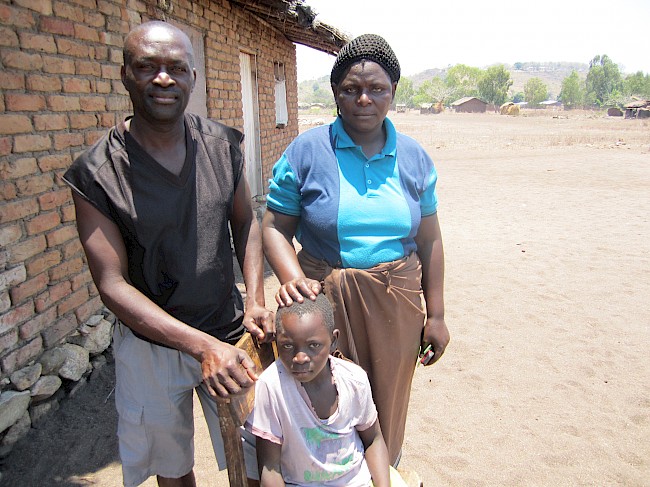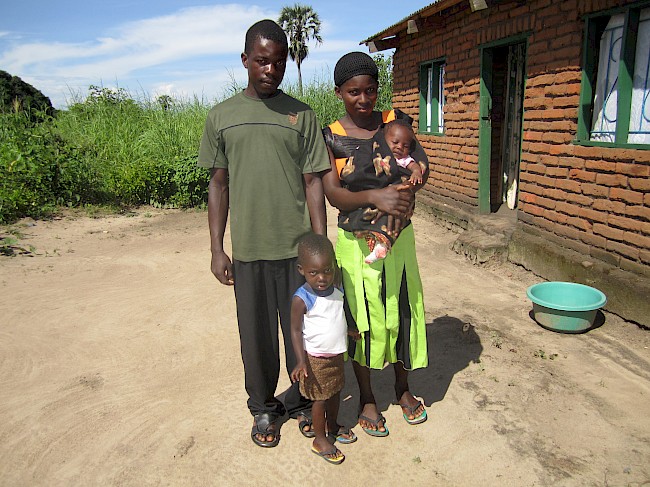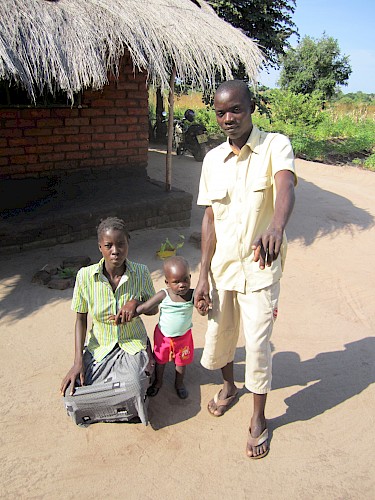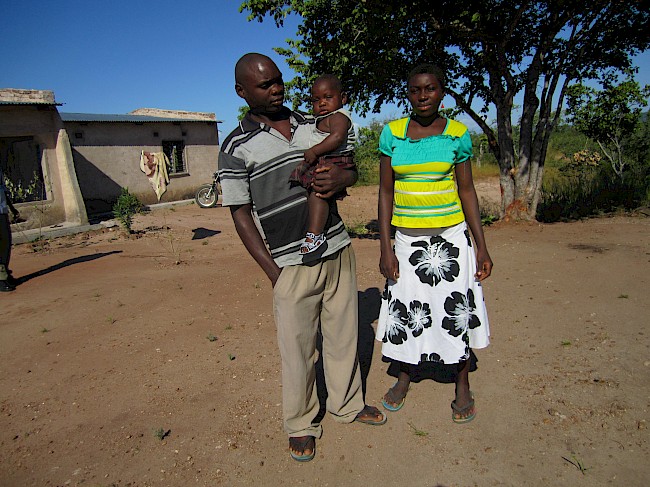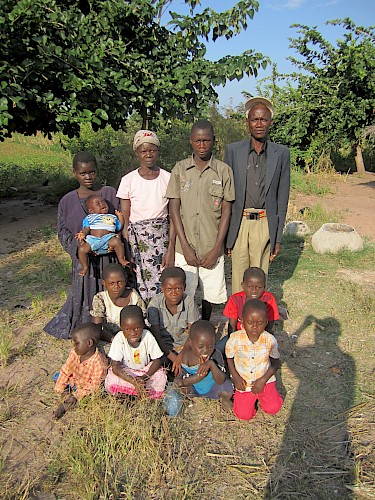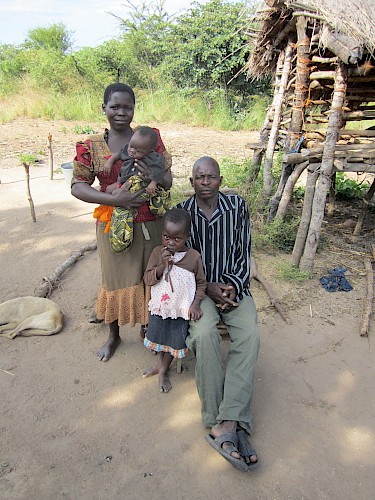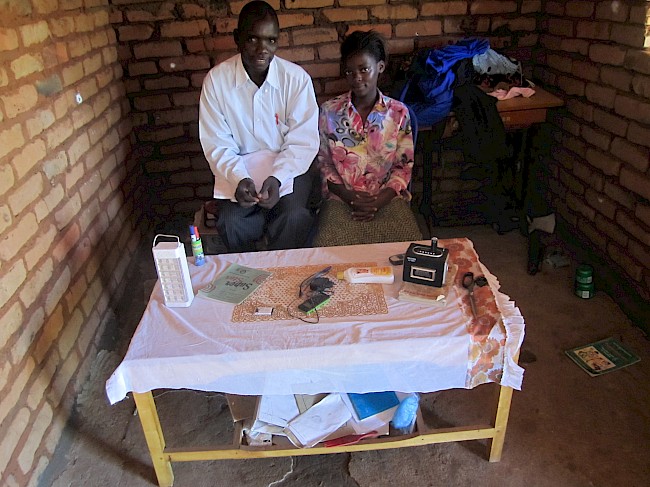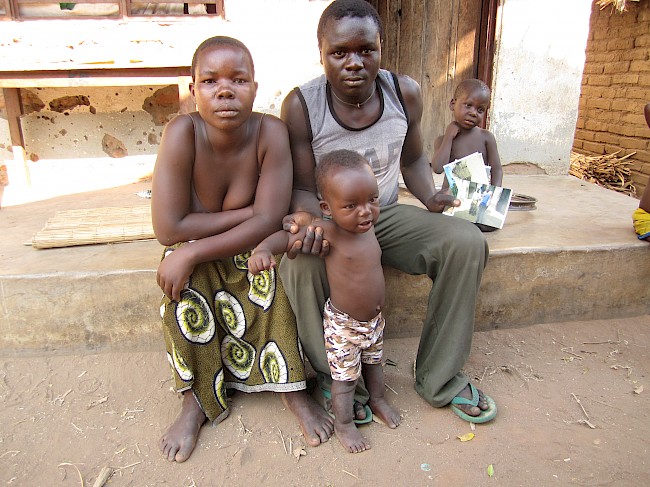Portraying fathers
Reproductive journeys in Malawi
—
Introduction
This photo essay uses family portraits to reflect on the complex meanings, values and calculations of fatherhood and fertility among men in Karonga District, northern Malawi. [note 1] Portraits are popular in this setting, and relatively commonplace due to the entrepreneurial photographers who travel between villages and offer their services to individuals and families.
From 2011 to 2013, the men and families pictured participated in research focused on their aspirations for and experiences of fatherhood. During a series of life story interviews these rural farmers, fishermen, teachers, and skilled laborers reflected on health issues ranging from contraceptive use to care for their partners during pregnancy, to HIV testing, to infertility. The narratives in this essay are drawn from those interviews, which were conducted in the local language of Chitumbuka and then translated into English by the authors.
Many fathers chose to be photographed with their spouses and resident children in front of their house or in their immaculately swept yards. Some men, notably those who did not have children, chose to be photographed at their place of work, with markers of achievement like cars, laptops, sewing machines, boats, and fishing nets. The aesthetic of the portraits also varied, from a respectful and composed stance (the majority), to an overt display of romantic gestures, to references to music and film. For instance, the couple in photograph 4 are linked hand in hand with their first child; his wife is respectfully seated and looks directly at the camera, while her husband stands and points – a pose drawn from music videos that are as much a part of rural modernity as reproductive health programs.
Health and development programs long assumed that rural African men were, at best, distanced partners in procreation, and, at worst, unthinking pronatalists whose influence should be minimized. However, a shift towards engaging men in interventions previously focused on women and children has become emblematic of a global turn towards gender-inclusive and gender-sensitive approaches to improving reproductive and child health (Dudgeon and Inhorn 2004). Today, Malawian men are being actively targeted by reproductive health interventions (Kululanga et al. 2011).
Malawian men’s pride at being portrayed as fathers in these photographs, and their willingness to share their procreative dilemmas and misfortunes, tells a more nuanced story of men’s relationship to reproductive health. This photo essay works against the tendency to homogenize ‘men’, and in particular ‘African men’, as a category of actors in the fields of sexual and reproductive health (Spronk 2014). Instead, we highlight the dynamic and contested nature of men’s roles in procreation, in relation to globalizing reproductive health discourses, practices, and technologies. These portraits of rural Malawian fathers are intended to inspire reflection on the diverse ways in which these men represent themselves as parents and partners. Their diversity and difference is crucial to understanding the context of reproductive health issues in Malawi.
Fatherhood and fertility
When a baby is born it becomes the most precious thing to you, the father, and all your relatives. If we can compare a person who has a child and one who has a vehicle – you find that the father is the one who is more highly valued.
This statement by the forty-six year old fisherman pictured in photograph 1 highlights the value placed on fatherhood in this patrilineal community. Becoming a father brings tremendous respect, and marks a significant transition in the life course. New fathers are told, ‘Kuba mulala sono (You are grown up now)’. Once their first child is born, parents are called after their first child’s name. A twenty-two-year-old farmer pictured in photograph 2 recalls, ‘[When] I heard the way my friends’ children called out “Dada, Dada!” I too wanted to be called “Father of Edi”’. Asked how he felt when his daughter was born, he replied, ‘I rejoiced, because my heart’s desire was fulfilled’.
The Tumbuka phrase ‘Mwanalume wa nkhongono (man of strength)’ was used to compliment a man with many children but the celebration of large families is changing. The twenty-two-year-old bricklayer pictured in photograph 3 said: ‘I debate with my friends: one says, “I’ll have three children”, the other one says, “I will have two children” – that’s how we discuss things when we chat. Since our currency was devalued we are buying everything at a high price. So it will be difficult to manage buying necessities for four or five children’. The devaluation of the Malawi kwacha in 2012, which caused prices to rise dramatically, spurred young men to consider how many children they could realistically support.
Fathers are concerned for their children’s futures – especially young men who have come of age in an era characterized by high adult mortality due to HIV/AIDS. As the young father in photograph 3 continued to explain, ‘My plan is to have two or three children. I want to buy them cattle in the coming years, so if I die they will be helped. They can say, “My father left me cattle to pay school fees’”.
Engagement with reproductive health interventions
Today, reproductive health initiatives aim at influencing men in their role as husbands through radio and peer- and health facility-led campaigns. These campaigns attempt to motivate men to take an HIV test with their pregnant partners, or to take an active role in antenatal care, for example. They provoke responses ranging from laughter to fear to relief. The man pictured in photograph 4, a twenty-six-year-old farmer and part-time NGO outreach worker, prides himself on having accompanied his wife to the antenatal clinic where they received HIV testing. In addition, he took on responsibility for providing proper care at home when she became pregnant: ‘I tried to make sure that she ate a balanced diet. We also reached a certain time when I disallowed her from doing certain kinds of work. I did that work myself’.
While Malawian men are increasingly taking on these kinds of roles, they sometimes use phrases like, ‘Ulimwanalume muwemi, kulondezga vyajenda (You’re a good man, you’re practicing gender equality!)’ to tease each other about their participation in traditionally female domains. Moreover, not all reproductive health initiatives are taken up with the same degree of enthusiasm. When the local hospital encouraged husbands to be present during the birth of their children, the farmer pictured in photograph 2 reflected: ‘I consider [HIV] testing together to be good, but being at the labor ward when a wife gives birth – to me that’s useless. The reason is, you can’t sit on the chair watching your wife in great pain as she gives birth!’
Men used theological as well as practical arguments to make sense of their increasing involvement in reproductive processes. The fifty-two-year-old fisherman in photograph 1 recalled the birth of his youngest child: ‘When the birth became difficult and long, many of us travelled there [to the district hospital] with my wife. I provided the money. I went because she could have needed blood. It would have been easier for me [rather than attending female relatives] to look for those blood donors. In all situations where marriage has connected us, we are supposed to be together because we are one body – the Bible says that’.
Postnatal care initiatives in this setting include family planning clinics and outreach to encourage men to use condoms or support their wives if they wish to use birth control (for example, hormonal injections) to space births. Both the financial and health benefits of spacing children resonate with men like the twenty-eight-year-old farmer in photograph 5: ‘We agreed that we should have a spacing of five years [between births]. A lot of money is spent taking care of the children or your wife when they are sick. But if we child space we can be free to use money for other things required in the house’.
Men’s involvement in interventions around female sterilization (after successive cesarean sections or birth complications, for example) is more conflicted. Although the aim of safeguarding maternal lives is not contested, sterilization garners mixed responses. The fisherman in photograph 1 responded, ‘[If your wife is sterilized] you have to behave as if you have also closed [been sterilized] and not disappoint the wife [by impregnating someone else]’. In contrast, the forty-four-year-old farmer pictured with his wives and their respective families in photographs 7 and 8 decided to marry again after his first wife was sterilized: ‘I had four children with my first wife. After two C-sections the hospital said, “If we cut her again we may lose her life”. I just accepted their decision and she closed her fertility [via sterilization]. So this is the reason I married another woman who now has one girl and one boy. This one is the last child and now I have six’.
Efforts to involve men in addressing infertility include requiring couples to attend clinical visits together, and providing testing for sexually transmitted infections and semen analysis for men. A diagnosis of male-factor infertility can leave men, just as it can leave women, at risk of divorce, particularly when there is no obvious treatment for their reproductive impairment (Parrott 2014). Some couples choose to remain in their childless marriages rather than remarry, however, and may refuse the divisive potential of a diagnosis. As the tailor pictured with his wife in photograph 9 states, ‘Ever since we met I have loved my wife. Both of us agree that it is God who gives children, therefore there cannot be quarrels between us’.
(click on images to view in slideshow mode)
Acknowledgements
We thank everyone who participated in bringing these words, images, and reflections to life, including the Karonga Prevention Study, Malawi, and the Amsterdam Institute for Social Science Research, University of Amsterdam. This work was supported by the Nederlandse Organisatie voor Wetenschappelijk Onderzoek NWO-WOTRO Innovational Research Incentives Scheme (VENI Grant C.2520.0299.01). Ethical approval was granted by the Malawi National Health Sciences Research Committee (NHSRC) and the London School of Hygiene & Tropical Medicine. All participants gave written informed consent and those pictured gave permission for the portraits to be used to share their stories.
About the authors
Fiona Parrott is a research fellow at the Amsterdam Institute for Social Science (AISSR) at the University of Amsterdam and holds a PhD in visual and material culture studies from University College London. Together with Dorothy Makoka, Green Kapira, Blessings Mwandosya, Aaron Ndovi, and Levie Gondwe from the Karonga Prevention Study, Malawi; Misheck Nkhata from Durham University; and Amelia Crampin from the London School of Hygiene & Tropical Medicine, she researched and curated the exhibition ‘Becoming Fathers: Reproductive Journeys in Malawi’. The authors share intersecting interests in the epidemiology, demography, and anthropology of health in Malawi.
References
Dudgeon, Matthew R., and Marcia C. Inhorn. 2004. ‘Men’s Influences on Women’s Reproductive Health: Medical Anthropological Perspectives’. Social Science & Medicine 59: 1379–95.
Kululanga, Lucy I., Johanne Sundby, Address Malata, and Ellen Chirwa. 2011. ‘Striving to Promote Male Involvement in Maternal Health Care in Rural and Urban Settings in Malawi: A Qualitative Study’. Reproductive Health 8, no. 36. http://dx.doi.org/10.1186/1742-4755-8-36.
Parrott, Fiona R. 2014. ‘“At the Hospital I Learnt the Truth”: Diagnosing Male Infertility in Rural Malawi.’ Anthropology and Medicine 21, no. 2: 174–88. http://dx.doi.org/10.1080/13648470.2014.915618.
Spronk, Rachel. 2014. ‘The Idea of African Men: Dealing with the Cultural Contradictions of Sex in Academia and in Kenya’. Culture, Health & Sexuality 16, no. 5: 504–17. http://dx.doi.org/10.1080/13691058.2014.889755.
Endnotes
1 Back
For more images and stories visit www.reproductivejourneysinmalawi.org
2 Back
There are 4 children in the portrait of this farmer with his first wife. They are grouped in front of a brick house.
3 Back
There are 2 children in the portrait with his second wife, and the husband sits on a chair by a thatched house.
